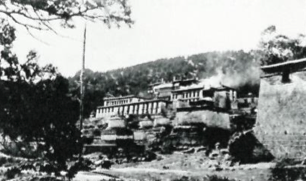The Chinese government’s recent crackdown on China’s Falun Gong religious sect has had only limited effect. The biggest result is a temperature rise in the hothouse of Chinese religious politics. This and other recent events again highlight the severe contridictions in China’s “commitment to allowing religious freedom” and its need to suppress what it views as hostile religious and politcal forces.
In early December, China officially installed a twelve-year-old boy named Gyancain Norbu to the seat of the Panchen Lama, the second leading Tibetan religious figure after the Dalai Lama. The cermony held under tight security at the Tashilhunpho Monastery in Shigatse, was reportedly carried out in spite of widespread antipathy by most Tibetans toward China’s nominee. Meanwhile, the Panchen Lama, who is recognized by the Dalai Lama and Tibet’s government-in-exile, a ten-year-old boy named Gedhun Choekyi Nyima, remains out of sight and under arrest by Chinese authorities who fear his destabilizing effect on China’s control of Tibet.
At the beginning of January, China suffered acute embarrassment when Ugyen Trinley Dorje, recognized as the 17th Karmapa Lama of the Tibetan Kagyu School, fled the country and arrived in India. In 1992, both the Dalai Lama and Beijing recognized the youth as the 17th incarnation of the Karmapa Lama, who died in 1981. As the only major lama recognized by both the Tibetan government-in-exile and the Chinese government, the Karmapa was cultivated by China to support its policies toward Tibet and help solidify its rule there.
But Ugyen Trinley Dorje’s position as head of the Kagyu School is not uncontentious. A rival of the Kagyu lineage and claimant to the position of 17th Karmapa, Thaye Dorje, lives in Sikkim, a disputed geographic region in northern India. Thus, complicated religious and geopolitical considerations weigh on the controversy surrounding Ugyen Trinley Dorje’s unexpected arrival in India.
While publicly downplaying the importance of the Karmapa’s departure, China has moved to tighten its grasp on the process of lama succession. In January, China installed its nominee for the position of the 7th Reting Lama, a boy named Soinam Puncog, at a cermony at Jokhang Temple in Lhasa. The Reting Lama, while not as well known as other major Tibetan lamas, has played an important role in Tibetan politics for 250 years. The Reting Monastery traditionally leads the search for the incarnation of the Dalai Lama. Reports speculate that the Chinese are maneuvering to control the search for the next rebirth of Tibet’s primary religious and political figure.
China’s consecration of five new Catholic bishops has also made headlines. Since the 1950s, China’s government has insisted on its right to appoint bishops to lead Chinese Catholics, forcing a schism between China’s “Patriotic Catholic Association” and the Roman Catholic Church, headed by the Pope. The Vatican refuses to recognize the Chinese government’s authority to appoint bishops. Mainland Chinese Catholics who remain faithful to Rome, estimated at up to eight million individuals, are known to practice their faith underground in China.

While China’s state-controlled media provides a stream of stories supposedly affirming the country’s commitment to religious freedom, the arrest or harrassment of Catholic clerics and laypersons who remain faithful to the Vatican continues. The Cardinal Kung Foundation, located in the United States, provides regular reports on the arrests and disappearances of Roman Catholics in China.
Amid this byzantine landscape, the Falun Gong sect has mounted a surprising challenge to the Chinese government’s attempts to control it (see article). In April of 1999, the group assembled ten thousand members at the gate of Zhongnanhai, the residential area of China’s government leaders, where it silently protested the central authorities’ policies. This event greatly alarmed officials, partly because it was organized quietly, through the Internet. Reportedly, China has arrested, jailed, and persecuted as many as 45,000 of the sect’s members and sent many of the group’s leaders to labor camps. Despite this, the group continues to carry out defiant acts, including public protests and, on one occasion, reportedly trying to replace Chairman Mao’s portrait that overlooks Tiananmen Square with one of their leader, Li Hongzhi. The Falun Gong’s activities are noteworthy as an ongoing nonviolent domestic movement, hardly precedented in recent Chinese history.
The Chinese government has condemned the Falun Gong as a heretical cult that most be stamped out. Moreover, similar groups have now come under severe scrutiny. This has led to profound, if hidden, conflict, since even high government officials are known to be members of Falun Gong or similar organizations. A top-positioned defense official previously endorsed and wrote the foreword for a book published by a similar group known as Huilian Gong. That group is also now under scrutiny.
In old China, times of economic distress spawned secret societies that opposed the imperial government. Now, durng China’s transition to a full market economy, social dislocation and uncertainties have contributed to the release of the same old genie, one most frightening to China’s political authorities.
Thank you for subscribing to Tricycle! As a nonprofit, we depend on readers like you to keep Buddhist teachings and practices widely available.